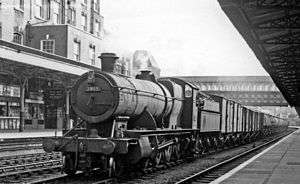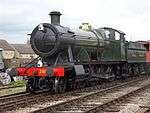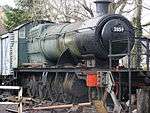GWR 2800 Class
The Great Western Railway (GWR) 2800 Class is a class of steam locomotive.
| GWR 2800 Class | |||||||||||||||||||||||||||||||||||||||||||||||||
|---|---|---|---|---|---|---|---|---|---|---|---|---|---|---|---|---|---|---|---|---|---|---|---|---|---|---|---|---|---|---|---|---|---|---|---|---|---|---|---|---|---|---|---|---|---|---|---|---|---|
 2818 (now preserved) at Newport High Street | |||||||||||||||||||||||||||||||||||||||||||||||||
| |||||||||||||||||||||||||||||||||||||||||||||||||
| |||||||||||||||||||||||||||||||||||||||||||||||||
| |||||||||||||||||||||||||||||||||||||||||||||||||
| |||||||||||||||||||||||||||||||||||||||||||||||||
History
The class was designed by G.J. Churchward for heavy freight work. They were the first 2-8-0 locomotive in Great Britain.
The prototype, originally numbered 97 but later renumbered 2800, appeared in 1903. Construction of the production series commenced in 1905 and continued until 1919. The 2884 Class which appeared in 1938–1942 was developed from the 2800 class and is sometimes classified with it.
Prototype
No.97 undertook two years of trials before going into production. Initial results suggested that only the front end needed further development. Initially the boiler pressure of the 2-8-0 was set at 200 lbf/in2 (1.4 MPa) with 18-inch (457 mm) diameter cylinders. Tractive effort started out at 29,775 lbf (132.45 kN) but was increased substantially in the production engines by enlarging the cylinder diameter to 18 1⁄2 in (470 mm) and raising the steam pressure to 225 lbf/in2 (1.55 MPa). The 8 1⁄2 in (216 mm) piston valves were enlarged to 10 in (254 mm).
Production
The most visible difference between No.97 and the first of the 1905 production batch was the higher pitch of the boiler (8 ft 2 in or 2.49 m opposed to 7 ft 8 1⁄2 in or 2.35 m). At first the prototype was given a 4,000-imperial-gallon (18,000 l; 4,800 US gal) tender but almost without exception the 2800s were harnessed to the 3,500-imperial-gallon (16,000 l; 4,200 US gal) variety throughout their working lives. Superheating was incorporated into the class from 1909 with No.2808 the first to be retro-fitted. Other modifications centred on improving the weight distribution, altering smokebox lengths and fitting larger diameter chimneys. The 84 2800s built by Churchward remained the GWR's principal long haul freight engines throughout the 1920s and 1930s. The only serious problem met with in traffic was with the sealing of the internal steam pipes. Beginning in 1934 most of the class had them replaced with the outside kind.
Oil firing
Between 1945 and 1947, coal shortages caused GWR to experiment with oil fired 2800 locomotives and 12 of the 2800 class were converted. They were renumbered into the 4800 series, which necessitated re-numbering the entire 4800 class autotanks into the 1400 series, and reclassified as 1400 class. The experiment, encouraged by the government was abandoned in 1948 once the extra maintenance costs were calculated and the bill had arrived for the imported oil.
Accidents and incidents
- On 6 January 1932, locomotive No. 2808 was hauling a freight train was in collision with a milk train at Didcot East Junction. The locomotive was extensively damaged. Ten wagon were destroyed and seventeen more were damaged. The milk train had overrun signals.[1]
- On 15 January 1936, locomotive No. 2802 was hauling a freight train that became divided at Shrivenham, Oxfordshire. An express passenger train collided with the rear portion of the freight due to errors by the guard and signalman. Two people were killed.[2]
Withdrawal
| Year | Quantity in service at start of year | Quantity withdrawn | Locomotive numbers |
|---|---|---|---|
| 1958 | 84 | 7 | 2800/1-2/14/20/27/38. |
| 1959 | 77 | 35 | 2803-4/8/10-12/15-17/23-26/28-29/32-33/40/43/48-49/63-64/68-70/78/80. |
| 1960 | 49 | 50 | 2805-6/9/13/21/30-31/35/37/44/46-47/50/77/81. |
| 1961 | 34 | 51 | 2819. |
| 1962 | 33 | 56 | 2834/53/55/60/83. |
| 1963 | 28 | 74 | 2807/18/41-42/45/51-52/54/57-58/61/65-67/71-72/74/82 |
| 1964 | 10 | 83 | 2822/36/39/56/59/62/73/75/79. |
| 1965 | 1 | 84 | 2876. |
Preservation
Six 2800 class locomotives survive, these being 2807, 2818, 2857, 2859, 2873, 2874, along with nine 2884 class locomotives. A seventh survivor was used to provide parts for other projects. Only two members of the class have so far operated in preservation, these being: 2807 and 2857, currently only 2857 is operational whilst 2807 is under overhaul which began in early 2020. One of the class, no. 2857, briefly operated on the main line in 1985.
| Number | Year Built | Withdrawn | Location | Status | Owner | Image | Notes |
|---|---|---|---|---|---|---|---|
| 2807 | Aug 1905 | Mar 1963 | Gloucestershire Warwickshire Railway | Under Overhaul | Cotswold Steam Preservation Ltd |  |
Salvaged from Woodham Bros in 1981 it was restored to running order at the Gloucestershire Warwickshire Railway, it is the oldest survivor of its class in preservation being 113 years old as of August 2018. |
| 2818 | Dec 1905 | Oct 1963 | Museum of the Great Western Railway | Static Display | Museum of the Great Western Railway | .jpg) |
Preserved straight from service. Previously part of the National Collection, ownership was transferred to STEAM Museum, Swindon in 2017 and the locomotive moved there in 2018.[3][4]Retains inside steam pipes and straight frames. |
| 2857 | May 1918 | Apr 1963 | Severn Valley Railway | Operational, boiler ticket expires: 2021 | The 2857 Society | .jpg) |
Purchased from Woodham Bros in May 1974 by the 2857 Society for £5,775 it was later moved by rail to the Severn Valley Railway in August 1975 and steamed for the first time in September 1979. As of 2018 the engine is the second oldest of the class to run in preservation becoming 100 years old in May 2018.
In 1985 during the 150th anniversary celebrations of the Great Western Railway it took a selection of the Severn Valley Railway's goods wagons to Newport for a Railfreight spectacular event.[5] The outward route took the engine via Worcester & Hereford with the return route being via Severn Tunnel Junction, Chepstow & Gloucester. |
| 2859 | May 1918 | Dec 1964 | Private Site, Congleton | Under Restoration | Private Owner |  |
Moved to Congleton from the Llangollen Railway for restoration in November 2017 following its sale to a private owner.[6] |
| 2873 | Nov 1918 | Dec 1964 | South Devon Railway | Dismantled | South Devon Railway |  |
Currently stored (frames only) at Buckfastleigh. |
| 2874 | Nov 1918 | May 1963 | Gloucestershire Warwickshire Railway | Under preparation for Restoration | The 2874 Trust | Currently in Barry Scrapyard condition but preparation for restoration is underway. Retains inside steam pipes and will be the only one of her class when restored running with inside steam pipes. |
2861, built in 1918, was one of the "Barry Ten" and eventually broken up for parts at the Llangollen Railway in 2014 and the frames scrapped. The cylinder and saddle block, along with several other components, are being used in the construction of replica GWR 4700 Class 2-8-0 No. 4709.[7]
Models
Hornby Railways manufacture a model of the 28xx in OO gauge.
References
- Anderson, E. P. (26 February 1932). "Great Western Railway" (PDF). Board of Trade.
- Hall 1990, p. 101.
- http://www.nrm.org.uk/aboutus/pressoffice/pressreleases/2017/august/2818-swindon?keywords=jobs
- https://twitter.com/steam_museum/status/1031571325758918661
- https://www.youtube.com/watch?v=NxA07x3Z-e4 2857 At Newport with the vintage goods train during the GW150 railfreight spectacular
- Wilcock, David (3 November 2017). "It nearly ended up on Ebay, but after 12 years a buyer is found for Llangollen 2-8-0". Steam Railway. No. 473. Peterborough: Bauer Media. pp. 8–9.
- http://www.4709.org.uk/pages/Archive%20News.html
| Wikimedia Commons has media related to GWR 2800 Class. |
- Classic British Steam locomotives
- Whitehurst, Brian (1973). Great Western Engines, Names, Numbers, Types and Classes (1940 to Preservation). Oxford, UK: Oxford Publishing Company. pp. 27–28, 103, 130. ISBN 978-0-9028-8821-0. OCLC 815661.